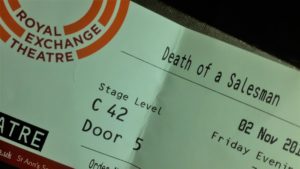Death of a Salesman Review by Pete Kalu (including a reflection on colour-blind casting)
I saw Arthur Miller’s theatre play, Death of a Salesman on 2 November 2018 at Royal Exchange Theatre, Manchester. Most of the cast were black in this version, including the main character, Willy Loman. Don Warrington is superb as Willy Loman. If one of Loman’s attributes is charm, then Warrington exudes this effortlessly. Really. I’d buy any used car off the guy when Don-as-Willy goes into charm mode. Flickers of Warrington’s debonair Rising Damp sit-com persona, Philip, come into my mind as I watch the early scenes.
And this is what interested me, phenomenologically, about Death of a Salesman. Arthur Miller once said the play was originally going to be called The Inside of his Head, and the play’s remarkable in the way it shuffles time and shows the presence of the past – of memory – in present, intense consciousness.
Which brings me to myself as a black member of the audience, watching this colour-blind casting: what goes on inside my head while watching Don Warrington play Willy Loman? First, the utter brilliance of Don Warrington. He delivers that mash of charm and bewilderment, of flattering, deluded hope, rage, tenderness, machismo, inarticulate love, the whole kaboodle of aching contradictions that make up Willy Loman. It’s delivered with aplomb, fabulously assisted by a talented cast – it’s no easy gig playing in RX’s theatre-in-the-round, and the RX team made it work, and some. But back to inside my head and colour-blind casting. What knocks around my skull when I watch Don play Willy?
First the ‘doubling’ of the action. Here is a life lived as if racism did not occur in the America of the 50’s in which Death of a Salesman is set. It’s a huge what-if that smokes its way all through the performance, a form of alternative history or shadow play: what would it have been like if there had been no racism in America at the time? Could a black man have been able to get Willy Loman’s job, and have a family life as saccharine, as idyllic (at least in memory) as Willy Loman remembers his?
Running alongside this stream of thought throughout, is its reverse: the thought that this play could only have been written by a white man. Only a white man would not comment upon the effect of race on a man’s prospects. I remember seeing Blues for Mr Charlie by James Baldwin in the same theatre. Baldwin would never have written Salesman. Which doesn’t make Salesman a lesser play. Not at all. But it brings to mind the meaning of white privilege: White Willy Loman could aspire to be the boss of the firm, whereas a black man knocking on that firm’s door would not even have got a foot on its lowest rung.
And then mingling with these two cross-currents of thought comes the wider, existential tragedy at the deep end of the play. Willy Loman kills himself. Even with the benefit of the privilege of being white in a racialised society like America at a time when whiteness was the assumed universal, Willy still found life unbearable. It invites us to think of the absurdity of life, whoever we are, wherever we are. What Albert Camus in L’Etranger called ‘the benign indifference of the universe’ smacks Willy Loman in the face. Smacks us all. Remorseless, indifferent Time finishes us all off sooner or later. It’s this last point that makes the play talk to anyone, everyone.
So much for the big thoughts.
Sticking with the phenomenological approach, another less abstract yet still parallel stream of thought I experienced while watching the play runs: how much are they paying this genius of an actor? Fame and fortune are arbitrary. Don Warrington was unsurpassable as Philip in Rising Damp. Here in Salesman, he shows that was no fluke. His talent endures. I have no idea if the man is loaded or broke – whether this gig he’s doing is a hobby or a financial necessity. Such is the life of an artist.
Then a more social stream of thought runs through here somewhere too. It goes: there are relatively few black people in the audience – why? When I go into a theatre or any other large space, I always scan for how many black people are around. Very few tonight. Theatre has always been claimed by a discourse that separates high art from low art. The arts council of Britain was set up in 1946 to foster ‘theatre, music and painting’. The sociologist Bourdieu famously expounded on how class markers are expressed through ‘taste’; knowledge of and attendance at the theatre is one of those markers. It amused me that on the night I went to see Death of a Salesman, there was a large sign in the theatre foyer, saying ‘Manchester Wine School’. You can’t get a better signifier of aspiring middle-classness than that! I laughed. Almost out loud. A theatre across town called Contact, tackled the problem of theatre’s class-based, virtue-signalling associations head-on by abolishing the word theatre from their title. It’s not Contact theatre they tell you, it’s Contact.
All this is not to say I don’t like theatre or other forms of ‘high art’. I attended a ballet only last week (La Fille Mal Gardee at The Lowry since you ask). There is great aesthetic value in those forms. Yet theatre, ballet and orchestras are not the only art. And now that the radical implications of Raymond William’s statement that ‘culture is ordinary’ is finally becoming understood, it is no longer controversial to say there is no hierarchy of art forms. Art of equal aesthetic value flourishes in many forms outside established art buildings. In Manchester, catch Cultureword or Young Identity poets, or Benji Reid’s artwork, or the singing protégés under Judith Shaw’s wings, or the amazing African art at Chuck Gallery. Else cross the Pennines to take in Leeds Carnival designer, Hughbon Condor’s mind-blowing costume creations. You get the gist.
So, back to inside my mind. I’m sitting in this citadel of middle-class art, conscious I am choosing to sit with these people in this place, and with this sense of ownership hovering above it, wine school and all. There are pluses to it. In Creative Industries terms, Royal Exchange is fully on the money here, producing a classic play, with a formidable cast, in an out-of-this-world building. It’s the kind of landmark event that maintains Manchester’s international profile and pulls the money in, the city powers say. It’s all a question of balance.
What else is going on inside my head? I enjoyed the play. I loved the live, sweating, humanness of the experience. Even if, as a play, it sometimes gets over-shouty for me (PS. if Miller loved a good ‘blokes, shouting’ scene, then David Mamet whacked that element to its testosterone max in Glengarry Glen Ross), it made me reflect on the messes, mishaps, failures and disappointments of my own life. Strange how art can do this: show you the nadir of misery – Willy Loman ends up killing himself – and yet leave you strangely uplifted. And so long as there are actors of the calibre of Don Warrington, and boards for them can tread, I’ll continue to love theatre. Hats off to RX. On with the show.
(Cedits: face artwork found on wall in Chapeltown, Leeds).




